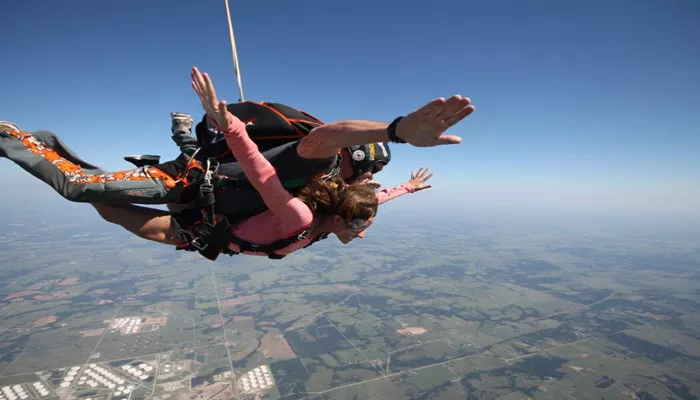Tandem skydiving is a thrilling experience that allows people to freefall through the skies while securely harnessed to a professional instructor. It’s one of the most popular ways to try skydiving for the first time due to its safety, simplicity, and excitement. However, before embarking on this adrenaline-pumping activity, understanding the weight limit is essential. This article will explore the weight restrictions for tandem skydiving, their rationale, and how they affect your experience.
Understanding Weight Limits in Tandem Skydiving
Skydiving involves the use of highly specialized equipment, including parachutes, harnesses, and reserve systems, all of which have weight thresholds to ensure safety. For tandem skydiving, the weight limit is generally determined by the type of equipment used and the operational guidelines set by skydiving centers.
Typical Weight Limits for Tandem Skydiving
Most tandem skydiving operators set their weight limit between 200 to 240 pounds (90 to 110 kilograms) for participants. Some providers may allow slightly heavier individuals, but this is subject to strict conditions, such as additional safety assessments or specialized equipment. The instructor’s weight is also factored into the total load capacity of the parachute system, which typically cannot exceed 500 pounds (227 kilograms) for both individuals combined.
The exact weight limit can vary depending on:
The skydiving center’s policies.
The manufacturer’s guidelines for the parachute system.
The physical fitness of the participant.
Why Do Weight Limits Matter?
The weight limit is not arbitrary. It is grounded in several safety and logistical considerations.
1. Equipment Safety
Skydiving equipment is engineered to handle specific weight ranges. Exceeding these limits can compromise the performance of the parachute during deployment and descent. Overloading a parachute system increases the risk of:
Harder landings.
Faster descent rates.
Equipment malfunctions.
2. Harness Fit and Comfort
The harness used in tandem skydiving must fit snugly and securely to keep the participant and instructor connected. Excess weight or an improper fit can increase the risk of discomfort, improper balance, or even disconnection during the jump.
3. Instructor Safety
Tandem instructors carry the responsibility of guiding the jump, deploying the parachute, and ensuring a safe landing. Carrying excessive weight may impact their ability to maneuver effectively, especially during high-stress moments like deploying the parachute or steering during landing.
4. Aircraft Weight Capacity
Small aircraft used for skydiving have strict weight limits. Exceeding these limits can affect the aircraft’s balance and safety during flight. Weight distribution is critical, especially in single-engine planes typically used for tandem skydiving.
What If You Exceed the Weight Limit?
If you exceed the weight limit set by a skydiving operator, you may face restrictions or additional fees.
Options for Overweight Participants
Specialized Equipment:
Some centers use stronger parachutes and larger harnesses for heavier individuals. This option may come with an extra charge.
Additional Fees:
Many skydiving centers charge an overweight fee for individuals over a certain threshold (e.g., 200 pounds). This fee typically ranges from $20 to $50 and covers the extra wear and tear on equipment.
Customized Solutions:
If you are slightly above the limit, some operators may conduct a case-by-case assessment, considering factors like your height, body composition, and overall fitness.
What If You’re Too Heavy?
In some cases, operators may refuse service if a participant significantly exceeds the weight limit. This is to protect both the participant and the instructor. It’s always best to disclose your weight honestly when booking to avoid disappointment or unexpected issues.
Preparing for a Tandem Skydive Within Weight Limits
If your weight is close to the limit, there are steps you can take to prepare for a safe and enjoyable experience:
1. Be Honest About Your Weight
Skydiving centers will ask for your weight during booking. Being truthful ensures the operator can provide the appropriate equipment and resources for your jump.
2. Wear Appropriate Clothing
Avoid bulky or heavy clothing during the jump. Lightweight, flexible clothing can help you stay within the limit and feel more comfortable.
3. Consider Losing Weight
If skydiving is a long-term goal, working toward weight loss through exercise and healthy eating can help you meet the requirements. Not only will this improve your chances of skydiving, but it will also enhance your overall health and fitness.
4. Check With the Operator
Every skydiving center has different policies and equipment capabilities. Contact the operator beforehand to confirm their weight limits and explore any available options.
Other Factors Affecting Weight Restrictions
Body Composition
Weight limits focus on overall weight, but body composition also plays a role. Taller individuals or those with muscular builds may be considered more favorably than shorter participants with the same weight.
Weather Conditions
Weather can influence weight restrictions. For instance, strong winds or high temperatures can reduce the effectiveness of parachute systems, leading operators to enforce stricter weight limits on a given day.
Health and Fitness
Some operators may assess your fitness level in addition to weight. Good physical health improves your ability to handle the intense sensations of freefall and landing.
Exceptions to Weight Limits
In rare cases, exceptions may be made for individuals who exceed weight limits but meet certain conditions:
Professional Consultation: A tandem instructor with advanced experience may approve an exception if the participant demonstrates good health and flexibility.
Specialized Centers: Some skydiving operators specialize in accommodating heavier participants, though availability may be limited.
Conclusion
The weight limit for tandem skydiving is typically between 200 and 240 pounds, though this can vary depending on the skydiving center and equipment used. These limits are crucial for ensuring the safety of both the participant and the instructor, as well as the reliability of the equipment.
Related topics:
- What Is The Most Common Injury in Tandem Skydiving
- How Old Do You Have to Be to Go Tandem Skydiving?
- How to Land Tandem Skydiving?

